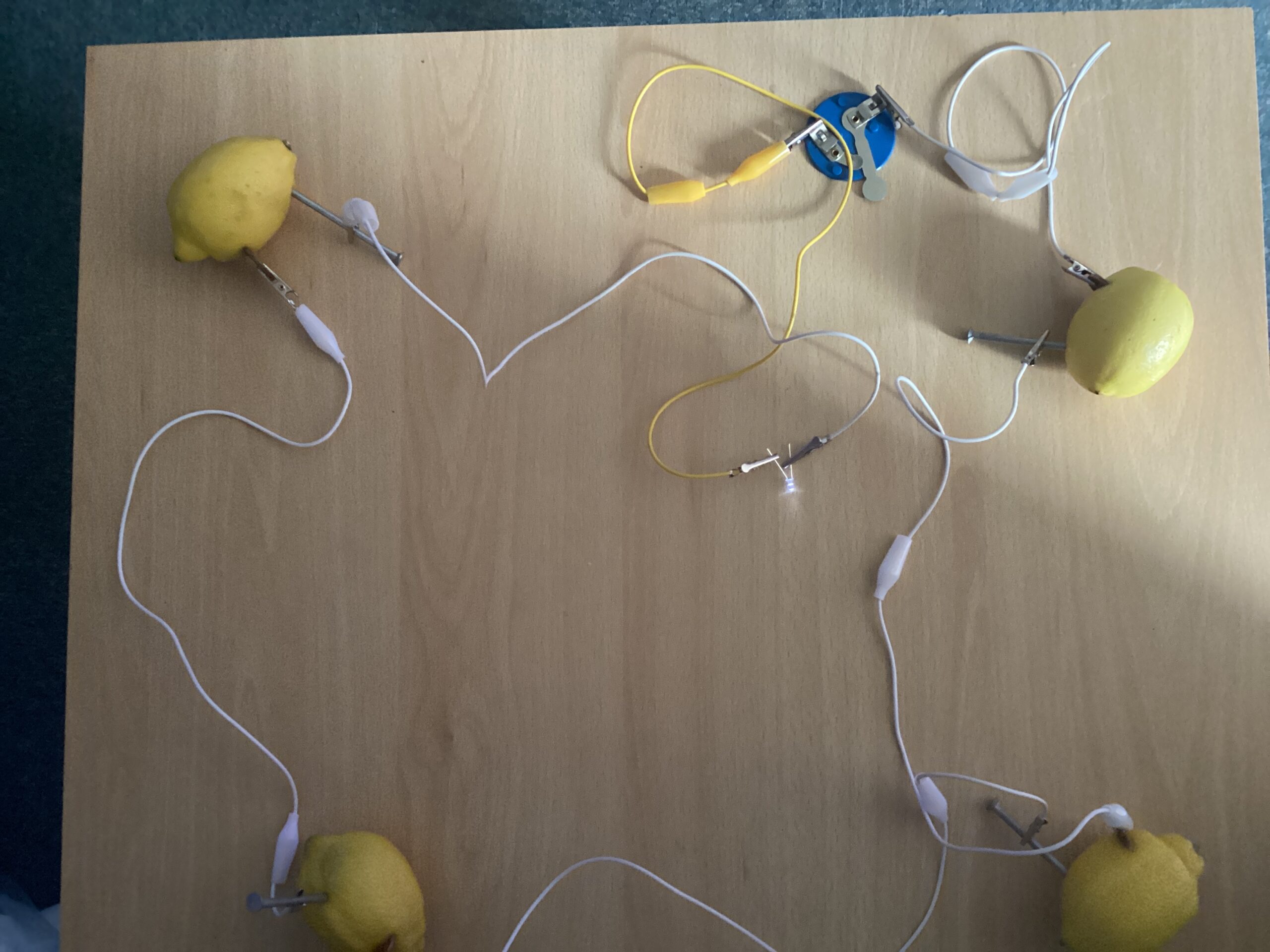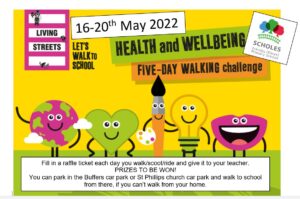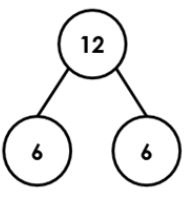Animal rangers – visit to Nursery
On Tuesday 24 May, the animal rangers will be visiting Nursery. They will be bringing along a wide range of animal species that will include a bearded dragon, rabbits, white tree frogs and many more.
This will be a great opportunity to learn interesting facts about different animals and their habitat. There will also be the opportunity to hold or touch some of the animals. Please alert your class teacher if your child has any allergies which may prevent them being around or touching any of the animals.
We are asking for a voluntary contribution per child towards the cost of the visit. This can be paid on the app. Please refer to your email for more details.
Unfortunately, on this occasion, we’re unable to invite those children that do not usually attend Nursery on Tuesday.
On the Farm
It has been a fun filled farm themed week!
We have continued our learning on our topic Life on Earth by exploring animals that may live and work on a farm.
We began our week by reading Farmyard Hullabaloo
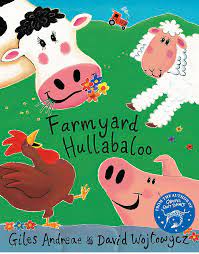
In Literacy, we worked together to read a page from the story. We used our tricky word knowledge and phonics skills to decode the words.
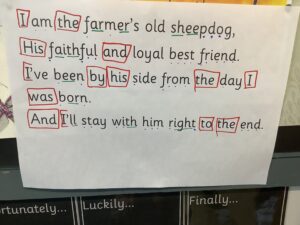
We wrote our own sentences about different animals.
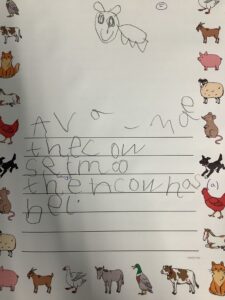
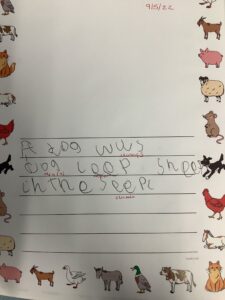
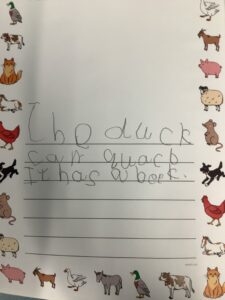
 .
.
In maths, we have been exploring 10 frames. We have built on our previous knowledge to make number bonds of 10.
Can your child tell you what number bond is been represented below?
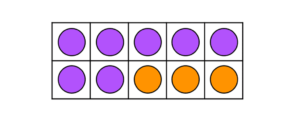
In the classroom, we have continued to watch the development of our caterpillars.
Two of them are in the cocoon at the top. Oliver
The caterpillars are in a cocoon. Lucille
The caterpillars are in a cocoon ready to be a butterfly. Raife
In art, we have used clay to create minibeasts.
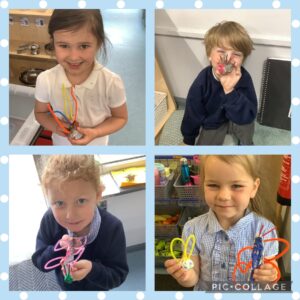

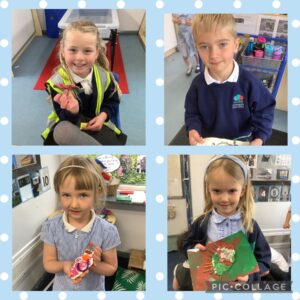
Check out our other fun learning inside and outside the classroom.
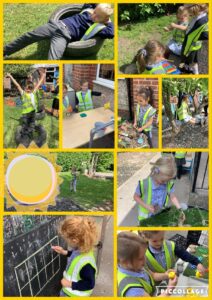
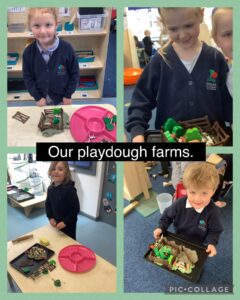
Home -Link
Write a list of animals that often live on farms. Do you know what their babies are called?
What the Ladybird Heard
We’ve enjoyed reading ‘What the Ladybird Heard‘ this week. It’s written by one of our favourite authors, Julia Donaldson. In the story corner, children enjoyed playing with the story props to re-tell the story and they were especially interested in the map that the burglars used to try and steal the fine prize cow.
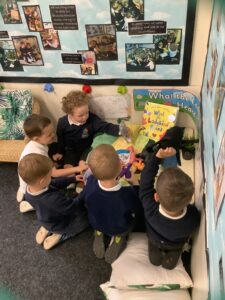
Children made their own maps and took them outside to locate the prize/treasure that they’d hidden.
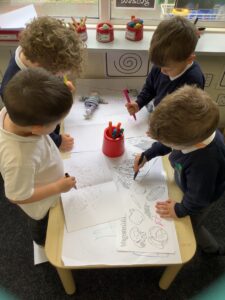


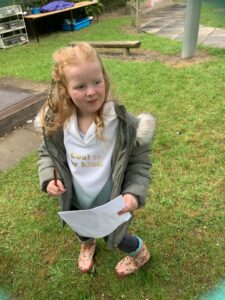

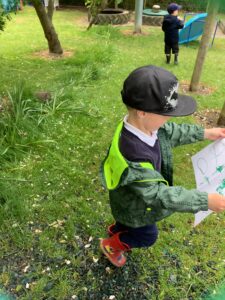
In group time, we played I Spy using the animals from the story. We had to listen very carefully to the sound. Some children noticed that some animals started with the same sound, such as ‘h’ for horse and hog. We’re working really hard to help children identify the initial sound in words at the moment. Have a go at playing I Spy at home this week to help reinforce this learning at home.
Here are a few other activities from this week:
- Exploring the texture of moon dough in the sensory area. It was very crumbly but you could also mould it in to mini sandcastles.
- Subitising spots on a ladybird
- Counting out the correct number of legs for our paper plate ladybirds
- Matching the number of spots on the ladybird to the numeral
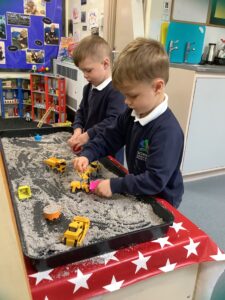



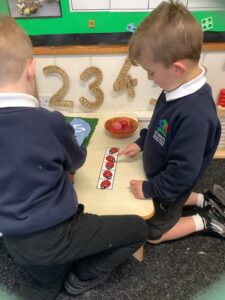
We were also very excited to find a chrysalis on Tuesday morning! We have one caterpillar left and it’s getting bigger and bigger.
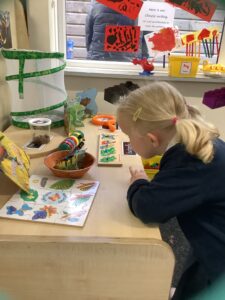
Finally, thank you to everyone that attended our drop-in session on Monday to look at your child’s Learning Journal. It was great to see parents and carers back in Nursery after such a long time of restrictions due to Covid-19. Our final drop-in session is on Wednesday 18 May from 4.15pm until 5pm, please call in if you can to have a look at what your child has been learning in Nursery this year.
Don’t forget – ‘Walk to school’ week!
Walk to School Week 16-20 May 2022
Next week is Walk to School Week (or scoot or ride).
We hope you’ll all try to take part in this, even if you can’t walk from home. The Buffers Pub and St Phillip’s Church have agreed for us to use their car parks so everyone has the opportunity to walk part of the way.
Remember to bring your raffle tickets each day you walk to put in your class boxes to be in with a chance of winning a prize!
Let’s get active!
Precious, pretty plants in pots
We’ve had many WOW! moments this week with our science topic, Plants.
We’ve watched our wonderful cress seeds germinate in just a few days, while testing which conditions are best for growth. Amazingly, some of the cress seeds have germinated without water – but after careful discussion we came to the conclusion that there must have been some moisture in the soil already allowing them to germinate. We’ve been nurturing with much care.
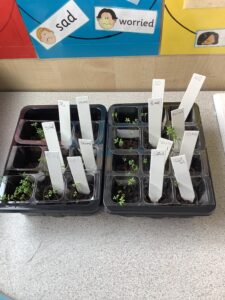
Now outside the classroom, we have repotted our broad beans now that they have started to grow. We carefully planted our delicate beans into the larger pots as we’ve learned that they space for the root to spread out. These we germinated without soil, just simply tissue paper and water. Hopefully soon, we’ll see a bit more growth in the soil over the next couple of weeks.
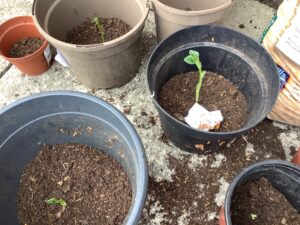
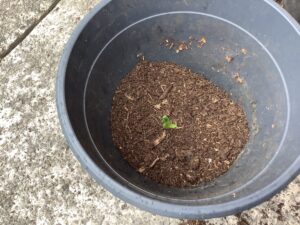
Inside the classroom, we have set up another observation experiment which is testing how water travels up the stems of flowering plants. The white flowers are in coloured water (food dye) to show how water is transported up the stem (like a straw). At the time of this photo, nothing had changed… look out for our results. The children made some accurate predictions about what they think the flowers might look like tomorrow.
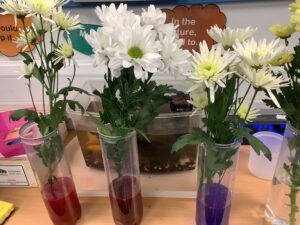
Maths – learning doubles
We have been working really hard on our maths fluency. We are trying to learn our doubles by heart, up to double 10. There are some excellent games on White Rose One Minute Maths or Top Marks. We’ve also played matching games, snap and used ten frames and part whole models to help.
Science – green plants
In our science topic we are learning all about green plants and growing. We have planted seeds and they have started growing in some classes already!
We will learning all about what plants need to grow and the difference between evergreen and deciduous trees.
We are measuring how much our seedlings grow each week.
Caterpillars
This week, we read another very famous book written by Eric Carle, ‘The Very Hungry Caterpillar’. Many children were already very familiar with the story, which allowed them to use their story telling skills in the book corner. If you have a copy at home, enjoy reading it together and see if your child can tell you the story in their own words using the illustrations on each page.
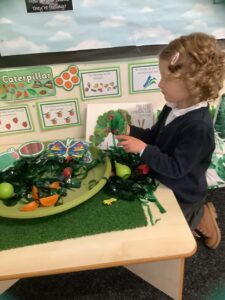
As we read the story, we also talked about the life cycle of a butterfly and learnt some new words including hatch and chrysalis. Can your child remember what a chrysalis is? In the story, Eric Carle refers to the home that the caterpillar makes with a different name – can they remember what word he used?
We’ve been watching our own hungry caterpillars very closely; they’ve already grown a lot. We’ll keep checking them next week to see what happens. Watch this space!

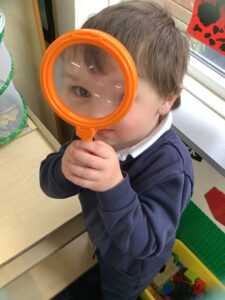
We added a few other caterpillar themed areas to Nursery, too. In the Fiddly fingers area, children enjoyed refining their fine motor skills by threading tiny beads onto a pipe cleaner to make some very tiny caterpillars. There were caterpillars to count in the maths area, caterpillars to make using playdough and spaghetti caterpillars to catch in the sensory area.

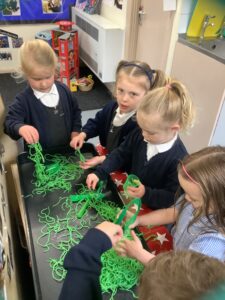
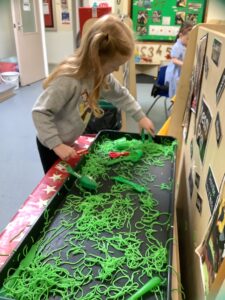

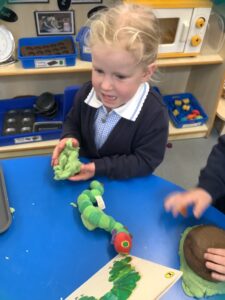
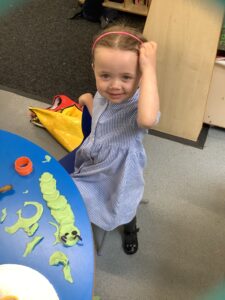

In maths, we’ve been talking about ‘more and less’. To begin with, we revisited some learning from earlier this year. We looked at 2 plates of cookies and talked about which plate had the most or fewest cookies. We asked children which one they would prefer and why. There were lots of comments which demonstrated their understanding: “I would choose that one because it has more” and “I want that one because there are 4 and that one only has 1 cookie on.” Children were very familiar with the terms ‘more’ and ‘most’, but they were less confident with the words ‘fewer’ and ‘fewest’. Try to use the words fewer/fewest at home this week to help consolidate this learning at home.
Next, we put 2 cookies on a plate that had been labelled with the numeral 3. Children were very quick to comment that we needed to put ‘one more’ cookie on the plate to make the number of cookies match the numeral. When we put 4 cookies on the same plate, they also knew it needed ‘one less’ and they took one cookie away. Great work, Nursery!
Outside, we continued with our gardening work; we’ve planted some more vegetable seeds and some ‘flower seed bombs’ near the fence at the bottom of the garden. There were lots of cars whizzing down ramps on the hill and the new fairy garden small world area was very popular.
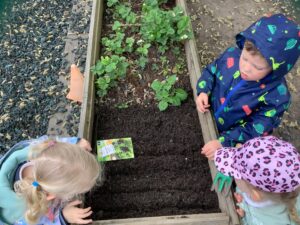
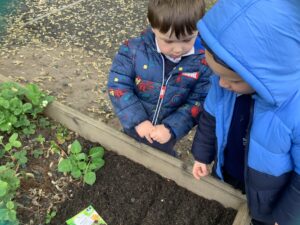
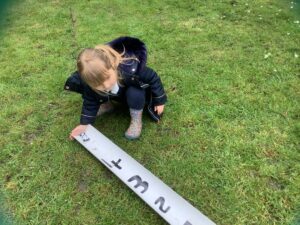
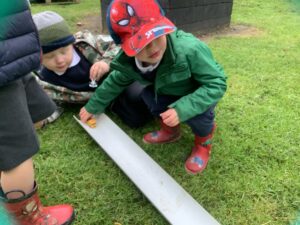
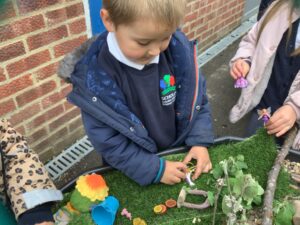
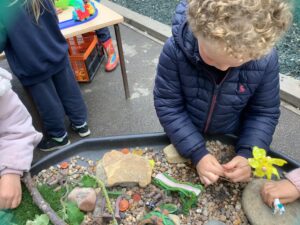

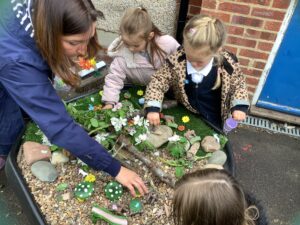
Mad About Minibeasts
We have all been ‘Mad About Minibeasts‘ this week. This is a fantastic book that has educated us on many of the minibeasts that we can find in our outdoor area.
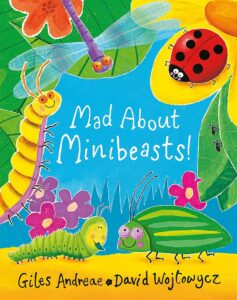
It has been wonderful to see children turning over stones and tree stumps to find woodlice, worms or centipedes. Children have also been finding spider’s webs and following ants to their nests. We have been trying to build our own minibeast house. Our provision indoors has also reflected our book.

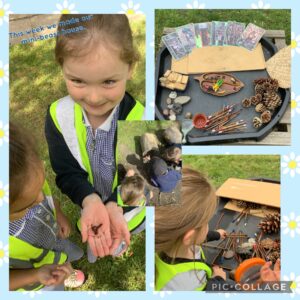
In Literacy we have been looking at rhyme in the book and making up some of our own. We have also written some short acrostic minibeast poems. Please continue to help your child at home by encouraging them to write for a variety of purposes (lists, maps, letters, stories etc). When helping them perhaps point out a letter they may need to practice the correct formation of or enable them to write the correct sound that they can hear in a word. This will really help your child on their journey to achieving the age related expectation for Reception. Remember the following too:
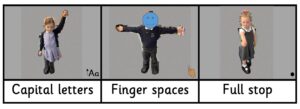
We certainly do enjoy writing and drawing!
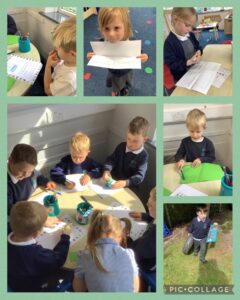
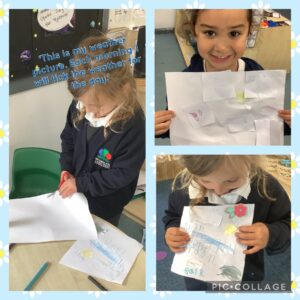
In Maths we have been composing 5 in lots of different ways.

Here are some other photographs of our learning this week:


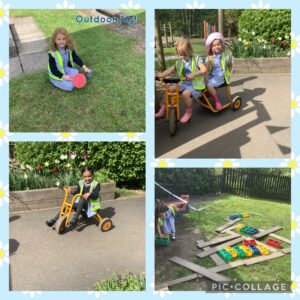
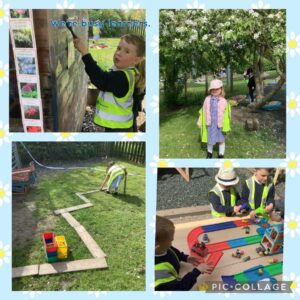
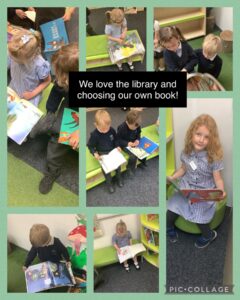
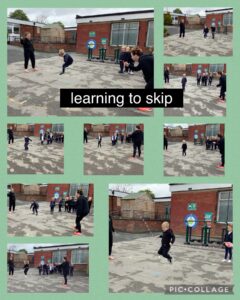
Home Link
This week could your child draw a picture of their favourite minbeast and write a fact about it.

Can fruit produce electricity?
We are continuing with our electricity unit in science and have been investigating whether fruit can produce electricity. How would this show how a battery works?
Lemons can be used in a circuit to power an LED. The juicy part of the lemon contains electrolytes that conduct electricity – approximately 0.7 – 0.9 volts. Four lemons are needed to power an LED. The children turned the lemons into batteries by using zinc nails and copper coins. The copper acts as the positive terminal of a battery and the zinc nail becomes the negative terminal. They then added the LED, wires and a switch. The LED lit up – hooray!
What other fruits or vegetables can be used in a circuit?
